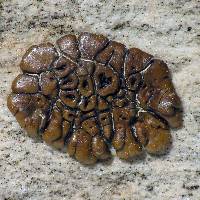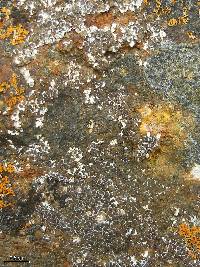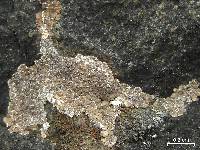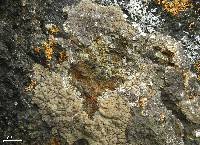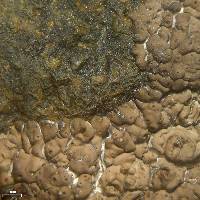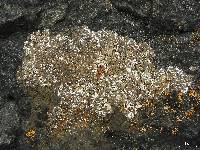
Consortium of Lichen Herbaria
- building a Global Consortium of Bryophytes and Lichens as keystones of cryptobiotic communities -
- Home
- Search
- Images
- Species Checklists
- US States: O-Z >
- US National Parks
- Central America
- South America
- US National Parks
- Southern Subpolar Region
|
|
|
|
Family: Acarosporaceae
|
Nash, T.H., Ryan, B.D., Gries, C., Bungartz, F., (eds.) 2007. Lichen Flora of the Greater Sonoran Desert Region. Vol 3. Thallus: predominately areolate, sometimes becoming sub-squamulose, forming indeterminate or determinate patches, overall up to 7 cm wide areoles: round to angular, lobed or not, less than 3 mm in diam., less than 1.2 mm thick, contiguous or dispersed; rim: down-turned, sometimes black upper surface: beautifully reddish brown to pale yellow-brown or dark black-brown, usually glossy, convex, epruinose lateral cortices: paraplectenchymatous, 40-50(-80) µm thick; cells: (3-)5-6 µm wide, sometimes opaque in water; syncortex: sometimes with visible periclinal hyphae 4-30 µm thick; eucortex: reddish brown upper layer 5-20 µm thick, hyaline lower portion 15-40 µm thick algal layer: ±even, algal cells ±arranged in vertical columns with strands sometimes extending into medulla medulla: white, intricately prosoplectenchymatous lower surface: usually dark with 5-6 µm apices of medullary prosoplectenchyma in pigmented globes appearing as paraplectenchyma, rarely white attachment: broad, eventually elevating areole without forming a stipe Apothecia: usually one per areole disc: dark reddish brown, epruinose, rough, round to irregular, immersed parathecium: 30-40 µm thick epihymenium: light to dark brown with diffused pigment, 10-20 µm thick hymenium: hyaline 80-120 µm tall; paraphyses: (1.3-)1.7-2(-3.1) µm wide at base, spreading in water; apices: slightly expanded up to 3-3.3(-5) µm wide, often with brown caps subhymenium: hyaline, indistinct, ±15 µm thick; hypothecium: 20-40 µm thick asci: clavate, 60-100 x 15-28 µm, 100+ spored ascospores: hyaline, simple, usually narrowly ellipsoid, 4-5.1 x 1.3-2 µm Pycnidia: not seen Spot tests: cortex K-; C± red, KC+ red, P-, UV ±pale green; in K a yellow color sometimes diffuses from areoles in many specimens Secondary metabolites: gyrophoric acid (major), lecanoric acid (minor), 3-hydroxygyrophoric acid (trace), methyl lecanorate (trace) (HPLC: J.A. Elix, pers comm.). Substrate and ecology: granite or volcanic rock in open areas, incidentally on limestone, sometimes invasive on other crusts World distribution: Europe, Asia, South America, and western North America Sonoran distribution: Arizona and southern California. Notes: Specimens of A. bullata from the desert and other arid microhabitats are often reduced, forming an effigurate and determinate thallus with variously shaped outer squamules. Eventually the thallus can become dispersed, and usually is either a pale yellow-brown or blackish brown. However, specimens from near the coast in southern California are usually a deep rich red-brown and have an indeterminate thallus. Western North American specimens, like the type, generally lack an intra-ascal sterile plectenchyma. The C reaction is best seen in a mount of the lower layer of the syncortex, but can be weak or absent in some squamules of a thallus and are best brought out with K. Nonetheless, some specimens respond poorly or unevenly to spot tests. Two synonyms, A. subcastenae and A. mendozana, are spot test negative specimens, but still contain gyrophoric and lecanoric acids. |
Powered by Symbiota



